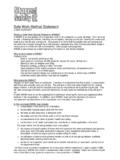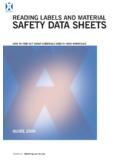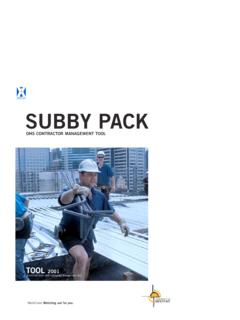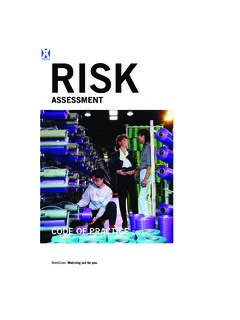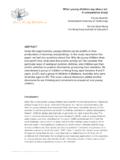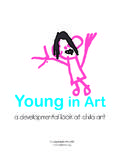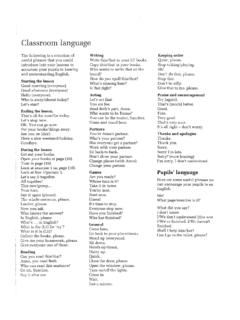Transcription of Safety at Work
1 Safety at WorkSafety at WorkThis booklet is published and promoted by the WorkCoverNSW Consumer Services Industry Reference Group Copyright: Commerce Queensland?OccupationalHealth and SafetyWhy Bother?You are probably aware that a largepercentage of persons employed inthe hospitality industry are eitherschool students or recent schoolleavers. The age of the workforcetogether with high levels of staffturnover raise occupational healthand Safety concerns in the a young worker in the HospitalityIndustry you stand a much higherrisk of being injured at work thanolder statistics show that a highproportion of workers under the ageof 24 will be injured during their firstyear at work .
2 Some of these injurieswill result in permanent disability,ongoing pain and in extreme concerning occupational healthand Safety designed to protect allworkers from injury are in place inALL states of are not exposed to hazardsYou are provided with a safe workplaceYou are trained to reduce your risk of injuryWhat are theBenefits?Occupational health and Safety benefitseveryone in the workplace including YOU!Occupational health and Safety laws ensure:-? Providing safe work areas,machinery and equipment; Providing a safe work process; Providing protective equipmentwhere needed; Providing information, instructionand trainingWho sResponsible?
3 What s myEmployerResponsible for?The law states you MUST also takecare of your own Safety and not putyour fellow workers at RISK OFINJURY. This requires you to; Follow health and safetyinstructions; Use personal protective equipment(PPE) and clothing in a correctmanner; Inform your employer about hazardsand injuries in your workplace; Co-operate with your employerregarding health and safetymatters so they are able to carryout their duties under occupationalhealth and Safety are myResponsibilities?What Hazardsshould I beaware of?!The law states you MUST alsotake care of your own Safety andnot put your fellow workers atRISK OF INJURY.
4 This requiresyou to; Follow health and safetyinstructions; Use personal protectiveequipment (PPE) and clothingin a correct manner; Inform your employer abouthazardsand injuries in yourworkplace; Co-operate with your employerregarding health and safetymatters so they are able tocarryout their duties underoccupationalhealth and GridExamples of HazardsType of WorkHousekeeping/Cleanup Hazardous substances in cleaning products Draining or disposing of used oil Blood or discarded needles (sharps) Biological wasteFood Service/Kitchen Wet & Slippery floors Deep fry equipment Hot cooking equipment and oil Sharp objects used in food preparationRetail/Sales Violent crimes Heavy liftingStorage/Receival Lifting, carrying, pushing & pulling work EnvironmentCanI Do Anythingto PreventAccidentsand Injuries?
5 If you are able to identify a hazard or potentialhazard in your workplace you are well on theway to preventing injuries and manual handling isthought to be the lifting ofheavy objects, however, it ismore widespread than handling refers toany activity that requiresthe use of a person s forceto lift, lower, push, pull,carry or otherwise move orrestrain an object. Taskscan range from the lifting ofheavy cartons/equipment tothose including repetitive orforceful movements and themaintenance of constrainedor awkward of manualhandling which you may beexposed to include;unloading and storing ofgoods, cleaning deep fryers,removing rubbish, setting up1.
6 So be alert to hazards!2. Let your employer know! and3. Follow instructionsto solve the problem!What abouttables and function rooms, makingbeds delivery or collecting of plates,cutlery and drink trays or servingcustomers. So you can see thatmany of the activities in yourindustry involve manual reduce the likelihood of sufferingan injury as a result of manualhandling, it s important to: Ask your employer for training inpreferred manual handlingtechniques, dealing with specificmanual handling hazards and inthe use of mechanical equipment; Try and organise your work somanual handling is limited; Reduce repetitive or sustainedbending, twisting and reachingwhere possible; Push rather than pull; Plan the task first; Use mechanical equipment whereavailable hoists, trolleys, stepladders etc.
7 When lifting or carrying keep theload as close to your body aspossible; Use team lifts where appropriateSpecific Hazards? HandlingDid you Know?Manual handling injuries usually result in strains and sprains to workers lower back, however they may also involve the neck and limbs. On occasionsinjuries may result in surgery or life-long disability affecting your career andsocial life. Workers under the age of 18 have bodies which are still developingand therefore are at greater risk of suffering a permanent injury. Injury mayoccur suddenly or develop gradually over a period of EnvironmentSlips, tripsand fallsTo reduce the likelihood of suffering aninjury as a result of slips, trips or fallsit s important to: Avoid cluttered work areas andfloors; Wear footwear appropriate to thetype of floor surface; Keep stairs and floors clean and dry; Ensure power cords are never placedacross walkways; Know the procedures for cleaningspilled substances and removal ofobjects causing a you know?
8 Slips, trips and falls account for a high proportion of injuries in the hospitalityindustry. Workers may experience injuries involving fractured bones, muscle strains,sprains, cuts and abrasions and in extreme cases, head injury (brain damage).Hot working conditions such as thosefound in kitchens may lead to heatrelated illness. This occurs when thebody is unable to lose heat fastenough to maintain a steady corebody temperature. Signs andsymptoms of heat related illness mayinclude one or more of the following:rashes, muscle cramps, weakness,dizziness, fainting, nausea andheadache. So to avoid suffering aheat related illness it s important to: Wear appropriate clothing (summerand winter uniforms etc); Drink water and rest in a cool area; Use ventilation/extraction and air-conditioning systems and informyour employer if they appear faulty; Be aware of emergency/first aidprocedures associated with heatrelated illness; Where possible work at your ownpace; Perform heavier work in cooler areasor at cooler times of the day; Be aware of heat illness you know?
9 Exposure to heat may aggravate other medical conditions such as high bloodpressure or existing heart problems. It may result in heat related illnessessuch as prickly heat, heat exhaustion (fainting), heat cramps or heat WorkingEnvironmentPl a ntPowered & Non-powered MachineryPlant refers to both powered and non-powered machinery. In the hospitalityindustry many pieces of machinery(plant) are used, including cutters,slicers, dicers, mincers and knives. Thereare a number of potential hazardsassociated with plant including; Moving parts ( guarding); Power source of equipment ( ); Noise; Hazardous substances ( fumes); Stability of equipment( bench mounted equipment); Use of pressure vessels( espresso machines).
10 You may be injured while using orcleaning machinery/equipment as aresult of coming into contact withmoving parts, or being trapped betweenmoving parts. You can reduce thechance of an injury when using plant by: Participating in training/instructionfrom your employer concerning thecorrect use of the equipment: ifunsure always ask; Checking that all guarding is in placebefore operation; Keeping equipment clean and in goodworking order; Turning off equipment prior tocleaning; Replacing all guards after cleaning iscomplete; Only using a machine for its using knives it is important to: Cut away from your body; Store knives safely with the bladepointing down; Use personal protective equipment(PPE) when required mesh gloves.
